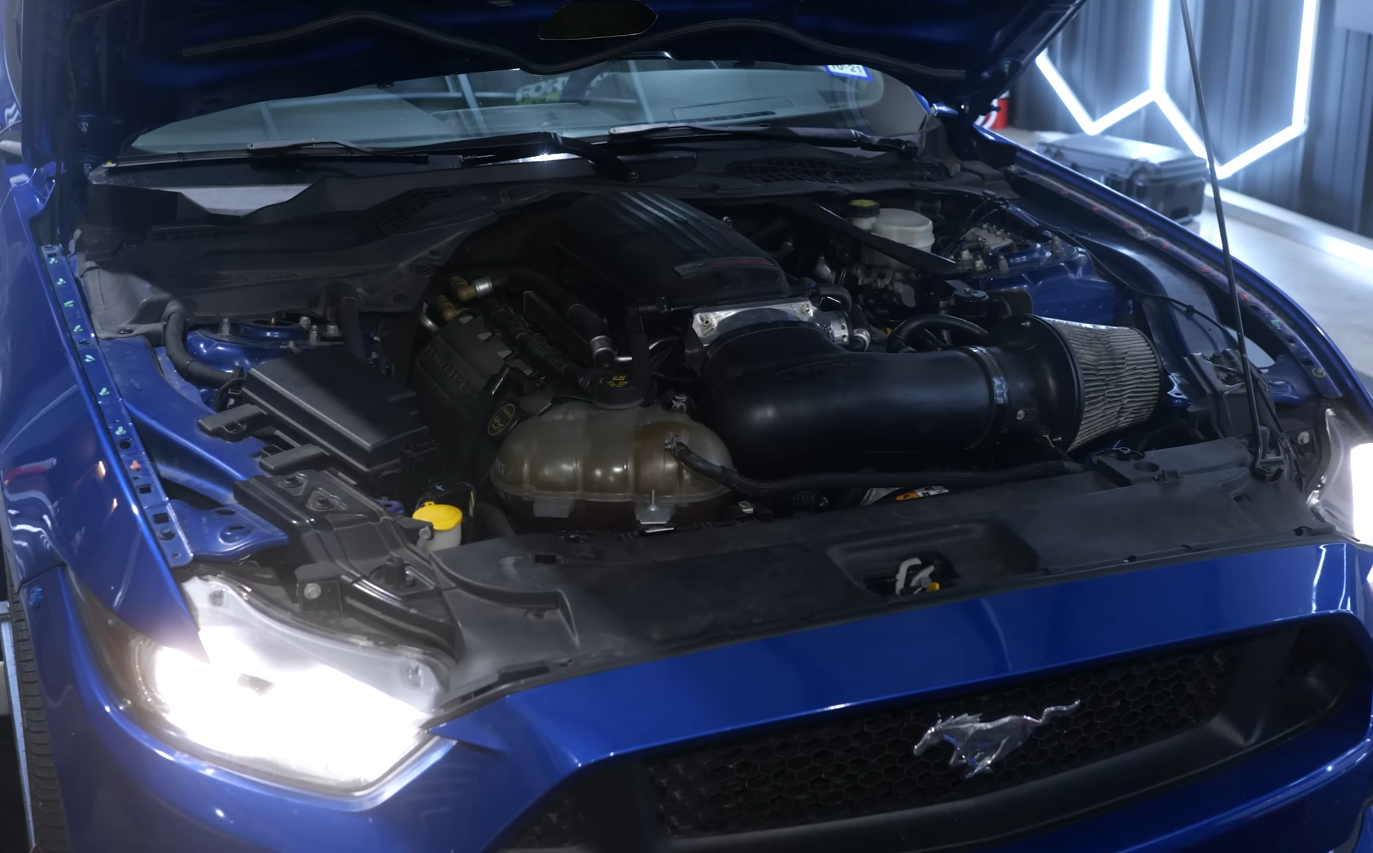Breaking in a Ford Mustang GT often means holding back on its full potential, and that was the case here. The driver kept the revs low and avoided aggressive clutch use, but still gathered plenty of first impressions. Early testing revealed the Ford Mustang GT sound levels, performance characteristics, and fuel economy, along with some limits in handling on tight roads.
Over time, attention shifted toward improving the Ford Mustang GT driving dynamics. Suspension upgrades, wheel fitment changes, and tire replacements became priorities to address a floaty, disconnected feel. The process involved detailed installation work, from removing stock components to fitting new coilovers and springs, all with the goal of making the car more responsive and capable on the road.
Key Takeaways
- The Ford Mustang GT delivered strong power but felt limited on narrow, winding roads.
- Measured sound levels placed it among the loudest in its group.
- Suspension and tire upgrades aimed to improve handling and road feel.
First Time Behind the Wheel
Early Miles and Driving Limits
During the first 500 miles, the driver kept the engine speed below 3,000 RPM and avoided aggressive clutch use. This cautious approach allowed time to get familiar with the car’s feel. On tight, winding roads, the Ford Mustang GT power was difficult to fully use, leading to a search for more open routes.
Measuring Cabin and Exhaust Volume
Noise testing showed the Ford Mustang GT reached 110–111.2 dB at wide-open throttle. This placed it between an RX-8 and an S2000 in loudness. Differences in measurement distance may have affected the results, but it remained the second loudest car in their group.
| Car Model | Measured Volume (dB) | Rank in Group |
|---|---|---|
| RX-8 | Higher than 111.2 | 1st |
| Mustang | 110–111.2 | 2nd |
| S2000 | Lower than 110 | 3rd |
Side-by-Side Driving Feel
Compared to a Civic, this Ford Mustang GT did not require constant throttle to stay responsive. The extra horsepower encouraged acceleration, but the narrow and curvy roads limited safe use of speed. At 405 horsepower without tuning, it delivered strong performance but felt less connected to the road due to a soft, floaty suspension. This led to plans for coilover installation and handling upgrades.
Driving Performance and Control
Engine Output and Speed Response
The Ford Mustang GT produces about 405 horsepower in its current untuned state. Testing showed it runs slightly rich, suggesting more power could be unlocked with proper tuning. While capable of strong acceleration, the engine’s full potential has yet to be optimized.
| Specification | Value |
|---|---|
| Horsepower | 405 hp (untuned) |
| Weight | ~4,000 lbs |
| Max RPM during break-in | 3,000 RPM |
Cornering on Tight Roads
On narrow, winding roads, the Ford Mustang GT’s power is difficult to use effectively. The driver often avoids full throttle to maintain control, especially on downhill sections. Compared to lighter cars, it feels less agile in sharp turns, creating a sense of caution rather than confidence.
Observed traits:
- Feels “floaty” and less connected to the road
- Stock suspension limits precision
- Requires more suitable roads to fully enjoy performance
Power Use in Real Conditions
The Ford Mustang GT strength lies in straight-line acceleration and open-road driving. In tight corners, much of the available power remains unused due to handling limitations. Suspension upgrades, including coilovers and lowering springs, aim to improve stability and make better use of the engine’s output.
Upgrades in progress:
- Fortune Auto coilovers for improved damping
- BMR lowering springs
- Existing camber and toe arms for adjustability
- Subframe brace for rigidity
Sound Level Checks and Evaluation
Noise Level Results
The Ford Mustang GT produced 110 dB at wide-open throttle on the first run, placing it between the RX8 and the S2000 in terms of volume. A later attempt reached 111.2 dB, but it still fell short of the RX8’s record.
| Test Run | RPM Range | Measured Volume (dB) |
|---|---|---|
| 1 | ~4,000 | 110.0 |
| 2 | ~3,000 | 111.2 |
| 3 | N/A | 111.0 |
The readings varied slightly due to testing conditions, such as the distance between the car and the measuring device.
Comparison to RX8 and S2000
The RX8 remains the loudest among the tested vehicles, followed by the Ford Mustang GT, and then the S2000.
- RX8 – Loudest recorded in this group
- Current Car – Second loudest, by a small margin
- S2000 – Quietest of the three
Differences in measurement distance during each test influenced the results.
How the Tests Were Done
The team measured sound levels during drive-bys at different RPMs. A phone-based decibel meter recorded the readings.
Key factors in the testing:
- Positioning of the measuring device relative to the car’s path
- Variation in RPM and throttle input
- Environmental conditions such as road layout and open space
Multiple runs were made to confirm results, with adjustments in speed and load to see if higher readings could be achieved.
Fuel Economy Details
During the drive, the Ford Mustang GT’s onboard display showed 7.4 kilometers per liter.
In different terms, that equals about 3.7 nautical miles per quart of fuel.
This is not high by typical passenger car standards, but the focus here is on performance rather than efficiency.
The vehicle produces around 400 horsepower and weighs roughly 4,000 pounds, so fuel use reflects its power and weight.
| Measurement Type | Value |
|---|---|
| Kilometers per liter | 7.4 |
| Nautical miles per quart | 3.7 |
| Horsepower | ~400 |
| Vehicle weight (lbs) | ~4,000 |
The driver noted that buyers seeking high fuel mileage would likely choose a different type of car.
Here, fuel consumption is a trade-off for performance capability.
Personal Feelings and On-Road Impressions
During the break-in period, the driver kept the engine under 3,000 RPM and avoided aggressive clutch use. This slower pace gave time to notice how the Ford Mustang GT feels in real driving. Noise levels stood out, with sound meter readings around 110–111 dB, placing it between an RX8 and an S2000 in loudness.
While the Ford Mustang GT offers about 400 horsepower, tight and winding roads made it difficult to use that power fully. On downhill sections, the driver often held back on the throttle to stay in control. They noted that the Ford Mustang GT felt more at home on open, straighter roads where its performance could be enjoyed safely.
Fuel economy was measured at 7.4 km/L, but efficiency was not a main concern. For the driver, the experience was less about numbers and more about the feeling behind the wheel—how the car responded, the sound it made, and the excitement it created when accelerating or cornering.
Key observations:
- Loudness: 110–111 dB range
- Power: ~400 hp, not fully used on twisty roads
- Fuel use: 7.4 km/L
- Driving feel: Best suited for open roads over tight corners
Suspension and Driving Comfort
Stock Suspension Review
The car’s original suspension felt loose and disconnected from the road, especially during spirited driving. The lack of adjustability limited fine-tuning for better handling. While the wheels could benefit from improved fitment, the bigger issue was the suspension’s inability to inspire confidence in tight or fast corners.
Upgraded Coilovers and Springs
The team installed Fortune Auto coilovers to replace the worn setup. These coilovers feature high-flow digressive pistons designed to balance ride comfort with performance. A dyno test ensures each unit stays within a 5% variance for consistent results.
In addition, BMR lowering springs were fitted, replacing the old springs paired with stock shocks, which were likely worn out. The new setup lowered the car’s stance and improved road feel.
| Component | Previous Setup | New Setup |
|---|---|---|
| Front/Rear Shocks | Stock | Fortune Auto Coilovers |
| Springs | BMR Lowering Springs | BMR Lowering Springs |
| Ride Height | Factory | Lowered |
| Damping Adjustability | None | Adjustable |
Alignment and Geometry Changes
The car already had aftermarket camber arms and toe arms installed, allowing precise alignment adjustments. A subframe brace was also in place, adding rigidity to the chassis. After lowering the Ford Mustang GT, camber was adjusted to improve tire contact with the road. These changes enhanced cornering stability and steering response, making the suspension more predictable under load.
Tire and Wheel Considerations
The tires were worn close to the wear bars, leaving only about 2 mm of tread. This level of wear reduces grip and makes replacement necessary for safe driving.
The car still had its factory shocks paired with aftermarket lowering springs. This setup can cause poor ride quality and, in this case, likely meant the shocks were already worn out. The suspension felt loose and disconnected from the road, which also affected steering feedback.
While the car already had some helpful upgrades—such as an adjustable camber arm, toe arm, and a subframe brace—the wheel fitment could be improved. Adjusting camber and upgrading to fresh, properly sized tires would help maximize handling and stability.
| Component | Current Condition | Recommended Action |
|---|---|---|
| Tires | ~2 mm tread left | Replace with new performance tires |
| Shocks | Stock, likely worn | Upgrade to match lowering springs or coilovers |
| Camber Arm | Adjustable, already installed | Fine-tune alignment |
| Toe Arm | Adjustable, already installed | Verify and adjust toe settings |
| Subframe Brace | Installed and functional | Retain for added rigidity |
Installation Steps and Obstacles
 Removing the Rear Brace and Subframe
Removing the Rear Brace and Subframe
The vehicle already had an aftermarket camber arm, toe arm, and a subframe brace installed. These components provided some adjustability and stability, but the brace needed to be removed to access the subframe.
- The brace was unbolted first.
- The subframe was then carefully lowered to prepare for the new springs.
Despite initial concerns, dropping the subframe proved easier than expected. The process required controlled, gentle lowering to avoid damaging components. Once in position, the subframe was torqued back to specification before moving forward.
Replacing Springs and Shocks
The Ford Mustang GT had BMR lowering springs paired with factory shocks. The shocks were likely worn from use with the lowering springs. The plan was to replace them with upgraded coilovers, reusing the original top hats.
Key points during replacement:
| Component | Condition | Action Taken |
|---|---|---|
| Lowering Springs | Installed | Removed |
| Factory Shocks | Likely worn | Replaced |
| Top Hats | Usable | Reused |
Once installed, the ride height was checked. The Ford Mustang GT sat noticeably lower, but the front camber still needed adjustment for proper alignment.
Disassembling the Front Suspension
The front suspension required more work due to the number of parts that had to be removed. The brake assemblies had to come off before the suspension components could be accessed.
Front removal steps:
- Remove brake calipers and rotors.
- Access and unbolt suspension components.
- Prepare for coilover installation.
This stage was more time-consuming than the rear because of the additional disassembly required, but it was necessary to complete the suspension upgrade.





 Removing the Rear Brace and Subframe
Removing the Rear Brace and Subframe
